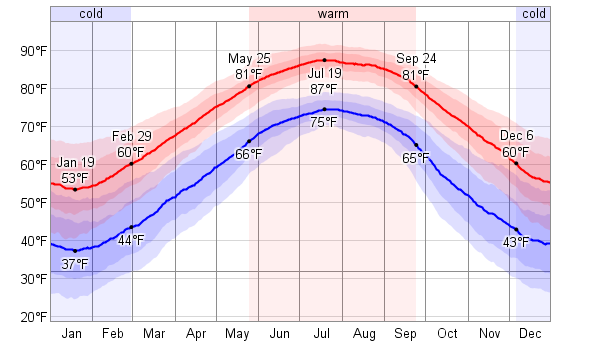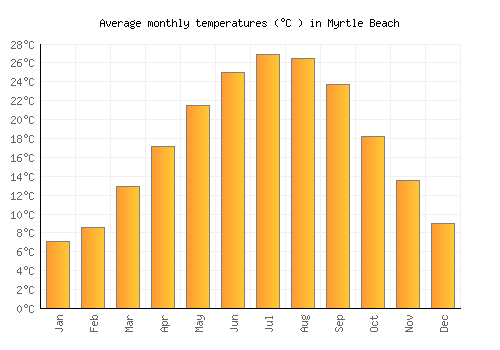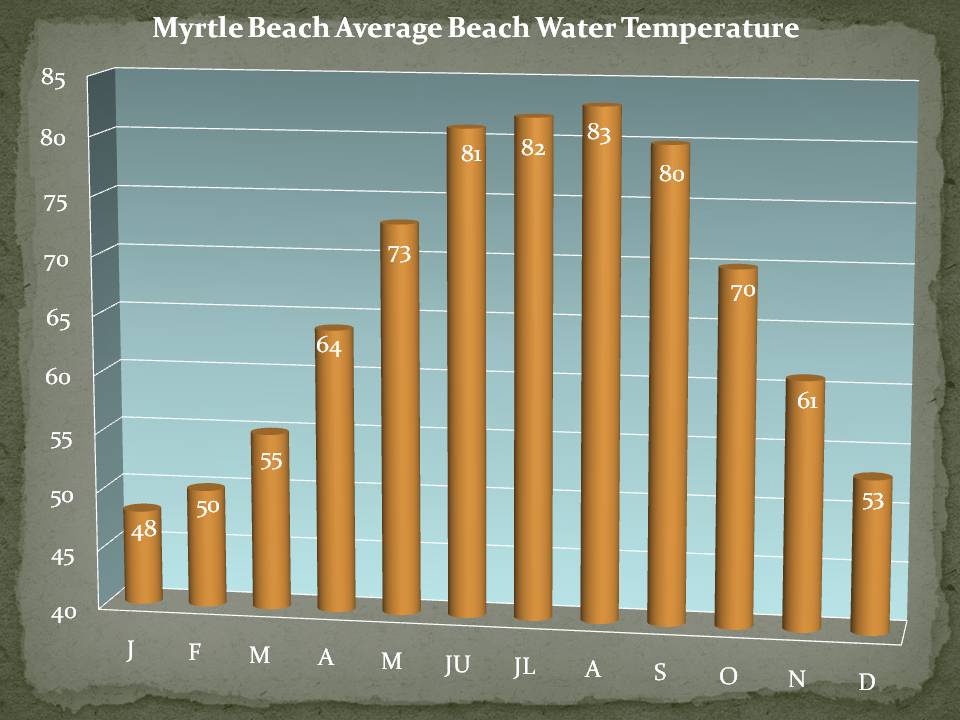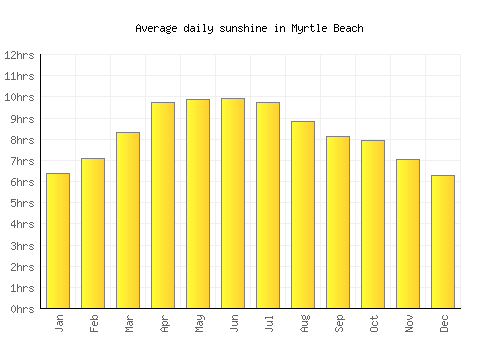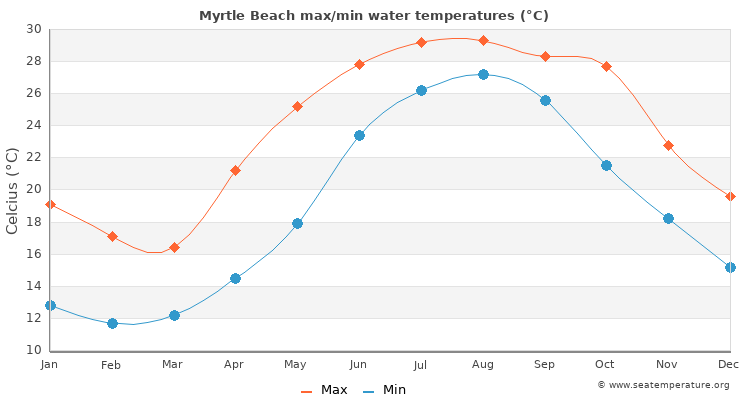February Temperatures In Myrtle Beach Sc
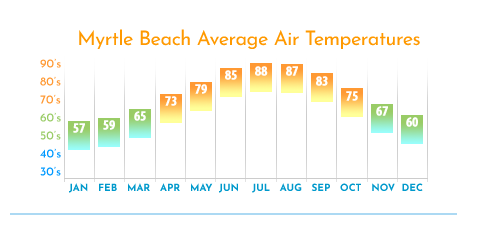
Myrtle Beach, South Carolina, renowned for its stunning beaches and vibrant tourism, experiences a mild winter climate compared to many other parts of the United States. Understanding the typical February temperatures in Myrtle Beach is crucial for homeowners, HVAC technicians, and facility managers to make informed decisions about heating and cooling systems. This article provides a comprehensive overview of February temperatures in Myrtle Beach and its implications for HVAC system selection, maintenance, and energy efficiency.
Average Temperatures and Climate Overview
February in Myrtle Beach is characterized by average high temperatures in the mid-50s Fahrenheit (around 13 degrees Celsius) and average low temperatures in the mid-30s Fahrenheit (around 2 degrees Celsius). While freezing temperatures are possible, they are typically short-lived. The humidity levels can be relatively high, contributing to a damp chill that can make the air feel colder than the actual temperature. Snowfall is rare but not entirely unheard of. The overall climate is considered subtropical, leading to moderate heating demands compared to northern states.
For homeowners, this means that a robust, high-powered heating system isn't generally required. However, a reliable and efficient heating system is still necessary to maintain comfortable indoor temperatures during the cooler evenings and occasional cold snaps. Understanding these temperature patterns helps in selecting the appropriate size and type of HVAC equipment.
Historical Temperature Data
Examining historical temperature data provides a more nuanced understanding of February weather patterns. Analyzing temperature records from the past few decades reveals that while the averages remain consistent, there can be significant year-to-year variations. Some years might experience prolonged periods of mild weather, while others might see colder-than-average conditions with more frequent dips below freezing. Reputable sources such as the National Weather Service (NWS) and local weather stations offer detailed historical data that can be invaluable for HVAC professionals and property managers.
HVAC technicians can utilize this data to anticipate potential service calls and adjust maintenance schedules accordingly. For instance, if a particularly cold February is predicted, technicians can proactively reach out to customers to schedule preventive maintenance checks on heating systems.
Impact on HVAC Systems
The mild February temperatures in Myrtle Beach have specific implications for the selection, operation, and maintenance of HVAC systems in homes and commercial buildings.
Heating Systems
Given the moderate heating demands, heat pumps are a popular and efficient choice for many Myrtle Beach residents. Heat pumps, which transfer heat rather than generate it, are highly effective in climates with mild winters. They provide both heating and cooling capabilities, making them a versatile option for year-round comfort. The efficiency of heat pumps is measured by the Heating Seasonal Performance Factor (HSPF). A higher HSPF rating indicates greater energy efficiency. Look for models with an HSPF of 8 or higher for optimal performance.
However, it's crucial to consider the heat pump's performance at lower temperatures. Some heat pumps lose efficiency when temperatures drop below freezing. In such cases, a backup heating system, such as electric resistance heat, might be necessary to supplement the heat pump during the coldest periods.
Furnaces, while less common than heat pumps, are still used in some homes. Natural gas furnaces offer high heating capacity and can be a cost-effective option if natural gas is readily available. The efficiency of furnaces is measured by the Annual Fuel Utilization Efficiency (AFUE). A higher AFUE rating indicates greater energy efficiency. Aim for furnaces with an AFUE of 90% or higher.
For smaller spaces, electric space heaters can provide supplemental heating. However, they are generally less energy-efficient than heat pumps or furnaces and should be used sparingly.
Cooling Systems
While February is primarily a heating season, it's essential to consider the cooling needs for the rest of the year. The average high temperatures begin to rise significantly in March and April, making air conditioning necessary for comfortable indoor environments. Therefore, when selecting an HVAC system, it's crucial to choose a unit that can efficiently handle both heating and cooling demands.
The efficiency of air conditioners is measured by the Seasonal Energy Efficiency Ratio (SEER). A higher SEER rating indicates greater energy efficiency. The minimum SEER rating currently mandated by federal regulations is 14, but models with SEER ratings of 16 or higher are readily available and can provide significant energy savings over the lifespan of the unit.
System Sizing and Installation
Proper system sizing is critical for optimal performance and energy efficiency. An oversized system will cycle on and off frequently, leading to uneven temperatures and increased wear and tear. An undersized system will struggle to maintain comfortable temperatures during extreme weather conditions. HVAC technicians use a variety of factors, including the square footage of the building, insulation levels, window efficiency, and local climate data, to determine the appropriate system size. Using Manual J calculations, which considers the heat gain and heat loss, helps accurately determine the proper sizing.
Proper installation is equally important. Even the most efficient HVAC system will perform poorly if it is not installed correctly. Ensure that the system is installed by a licensed and experienced HVAC technician who follows industry best practices. Regular maintenance, including filter changes, coil cleaning, and ductwork inspections, is essential for maintaining optimal performance and extending the lifespan of the system.
Energy Efficiency and Cost Considerations
Energy efficiency is a major concern for homeowners and property managers, especially given rising energy costs. Investing in energy-efficient HVAC systems can significantly reduce utility bills and lower your carbon footprint.
Energy-Saving Tips
Besides installing energy-efficient equipment, several simple measures can further enhance energy savings:
* Programmable Thermostats: Use programmable thermostats to automatically adjust temperatures based on occupancy and time of day. * Insulation: Ensure that your home or building is properly insulated to minimize heat loss during the winter and heat gain during the summer. * Duct Sealing: Seal any leaks in your ductwork to prevent conditioned air from escaping. * Regular Maintenance: Schedule regular maintenance checks to ensure that your HVAC system is operating at peak efficiency. * Window Treatments: Use curtains or blinds to block sunlight during the hottest parts of the day and to insulate windows during cold nights.Cost Analysis
The initial cost of an HVAC system can be substantial, but it's important to consider the long-term savings associated with energy-efficient models. While higher-efficiency units typically have a higher upfront cost, they can significantly reduce your energy bills over the lifespan of the system. A thorough cost analysis should consider the initial purchase price, installation costs, operating costs (including energy consumption and maintenance), and potential rebates or tax credits.
Many utility companies offer rebates for installing energy-efficient HVAC systems. These rebates can help offset the initial cost and make energy-efficient upgrades more affordable. Federal tax credits are also available for certain energy-efficient improvements.
HVAC Maintenance in February
February is an ideal time to perform routine maintenance on your HVAC system to ensure it's ready for the upcoming spring and summer months. While the heating system has been the primary focus during the winter, it's crucial to prepare the cooling system for the warmer weather.
Maintenance Checklist
* Filter Replacement: Change air filters regularly (typically every 1-3 months) to maintain good airflow and prevent dust and debris from accumulating in the system. * Coil Cleaning: Clean the evaporator and condenser coils to remove any dirt or debris that can reduce efficiency. * Ductwork Inspection: Inspect ductwork for leaks and seal any cracks or holes to prevent air loss. * System Checkup: Schedule a professional HVAC technician to perform a comprehensive system checkup, including inspecting electrical connections, checking refrigerant levels, and testing the system's overall performance. * Outdoor Unit Cleaning: Clear any debris, such as leaves or branches, from around the outdoor unit to ensure proper airflow.For facility managers overseeing large buildings, implementing a preventive maintenance program is essential. This program should include regular inspections, filter changes, coil cleaning, and system performance monitoring. A well-maintained HVAC system will not only operate more efficiently but also have a longer lifespan, reducing the need for costly repairs or replacements.
Conclusion
Understanding the February temperatures in Myrtle Beach, SC, is crucial for homeowners, HVAC technicians, and facility managers to make informed decisions about heating and cooling systems. The mild winter climate allows for the efficient use of heat pumps and other energy-saving technologies. Proper system sizing, installation, and maintenance are essential for optimizing performance and minimizing energy costs. By following the tips and guidelines outlined in this article, you can ensure comfortable and efficient indoor environments year-round.
By considering factors like HSPF, SEER, and AFUE ratings, one can make an informed choice about which equipment will best suit one’s needs. Also, remember to factor in the lifespan of a unit. For example, a well-maintained heat pump can last 15-20 years, and a furnace can last even longer. Always keep in mind the importance of professional installation and regular maintenance to maximize the efficiency and lifespan of your HVAC system.
Disclaimer: This article is intended for informational purposes only and should not be considered a substitute for professional advice. Consult with a qualified HVAC technician for specific recommendations tailored to your individual needs and circumstances.

